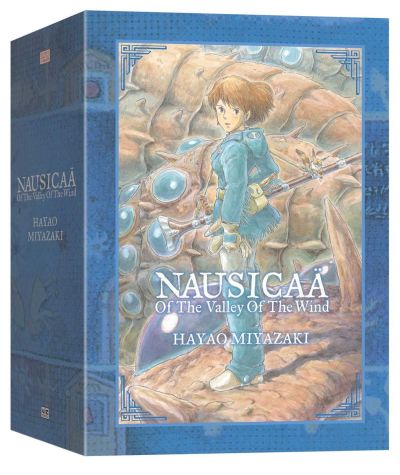Bloom and Fade Away
Nausicaä of the Valley of the Wind
By Hayao Miyazaki

10 Mar, 2021
0 comments
Hayao Miyazaki’s manga Nausicaä of the Valley of the Wind (Kaze no Tani no Naushika) is a post-apocalyptic science fantasy. It was serialized in Animagefrom February 1982 to March 1994.
A thousand years after the Seven Days of Fire, declining human populations cling to existence in those few regions that are still habitable for humans. Much of the Earth’s land surface is covered in thriving ecosystems, but … all these systems — the so-called Sea of Corruption — feature “miasma,” a toxic fog lethal to unprotected humans.
The Valley of the Wind is lucky. Continual winds keep the miasma at bay, protecting the Valley’s inhabitants. Life is still harsh and short but compared to elsewhere, it is paradise.
Unfortunately for the Valley of the Wind, it is a vassal state of the Vai Emperor of the Torumekians.
When the Vai Emperor resolves to invade the Dorok lands, the Valley is expected to contribute soldiers. Since the Valley’s chieftan Jhil is bedridden and close to death, it falls to his daughter Nausicaä to lead the Valley’s levy of doddering, expendable old soldiers to join Princess Kushana’s forces.
The Torumekian imperial family is just as set on crushing each other as they are on conquering the last pockets of habitable land. Thus, Princess Kushana is in more danger from her ambitious, cruel brothers than she is from the Doroks. If killing Kushana will destroy her army, that is the price her brothers are willing to pay.
Although higher technology was lost in the Seven Days of Fire, knowledge that it existed was not. Kushana would dearly like to get her hands on one particular relic of the pre-Seven-Days era. She is completely unaware that by chance — or perhaps fate — the very item she seeks has fallen into Nausicaä’s hands. If used, it will revive an evil from the pre-Seven Days, a weapon that will ensure Torumekian victory and Kushana’s triumph over her loathsome siblings.
Or perhaps, in combination with Dorok superweapons, the relic will simply destroy what’s left of humanity.
~oOo~
Like a lot of North Americans, my first exposure to this was the animated movie or rather the American cut of the Japanese original: Warriors of the Wind.

Not only did the animated movie leave out much of the plot of the manga (because when the movie came out, the manga’s run had another decade in front of it), but the US version embraced a very bold editorial strategy so forthright in its approach that Miyazaki would later insist North American importers leave every frame of his films in place. Nevertheless, Warriors the Wind caught my interest.
For reasons that become clear later in the series, Doroks and Torumekians have a somewhat inconsistent technological kit, mixing mounted cavalry

with gliders and powered aircraft little inhibited by aerodynamics1. The aircraft are built around durable relics of the old era. It’s as though the manga was written and drawn by a man fascinated by aircraft who was determined to fit them in whether or not they suited the tech level!
I was particularly interested by the alien ecology that dominates the landscape. Miyazaki’s future Earth is as strange to modern eyes as the Earth of the Ordovician and Late Devonian would be. It is a future Earth where the land is covered by enormous fungal spires and the air filled with giant insects who have somehow evaded the square-cube law.
This isn’t a fun war story where the heroes defend their land from faceless hordes. This is more the “ignorant armies clash by night” kind of war story. Both sides are led by self-serving monsters, both sides have sympathetic characters, almost anyone can die in a spray of blood and body parts, and both sides have researchers eager to dabble in that which should not be dabbled in. The end result: a world much less suited for human life.
Not all of the aristocrats are monsters. In any other series, Kushana would the protagonist (in this one, she’s upstaged by Nausicaä), She’s a sympathetic figure in many ways; it’s a shame that some of her goals are poorly chosen (lack of information on her part, no way her fault). Kushana is at least a more interesting character than the manga’s ostensible protagonist. Nausicaä has many fine qualities but she is too hemmed in by her role to be interesting.
The work offers a melancholic view of human potential, suggesting that not only could human folly bring us to the brink of extinction, but that this might not be such a bad thing. Curious, therefore, that despite bloodshed and air of impending doom, the work avoids bitter nihilism.
Nausicaä of the Valley of the Wind is available here (Amazon US), here (Amazon Canada), here (Amazon UK), here (Barnes & Noble), here (Book Depository), and here (Chapters-Indigo).
1: While the larger aircraft are implausible, Nausicaä’s personal flyer Möwe(Gull) is convincing enough someone actually built and flew one.
